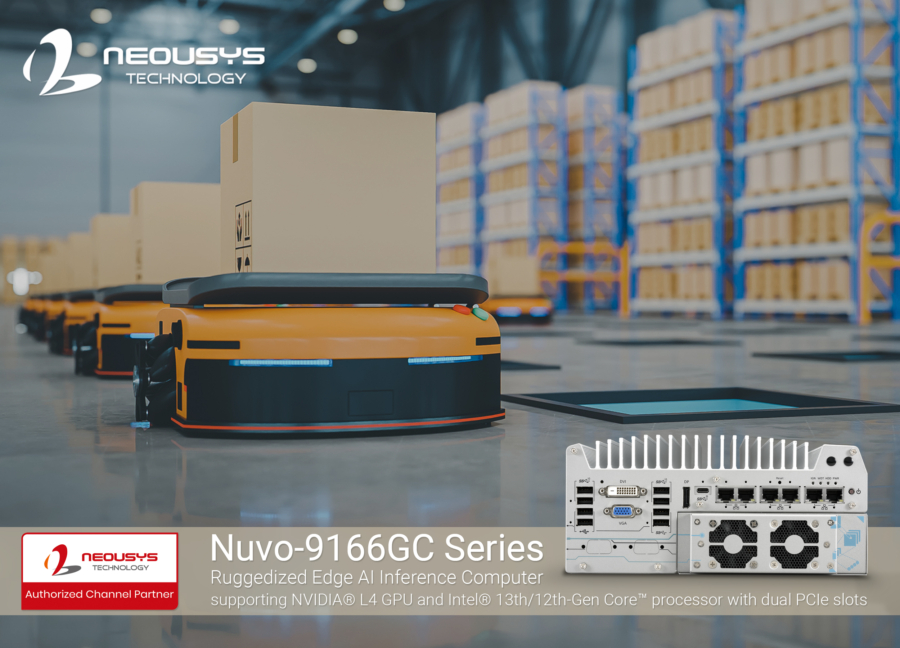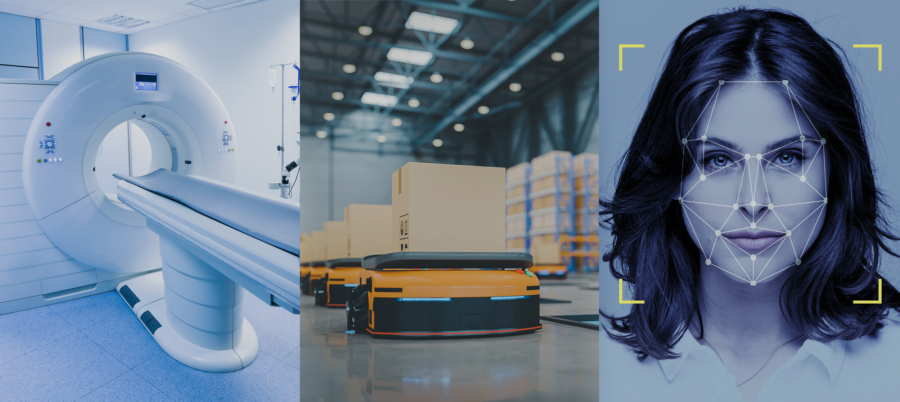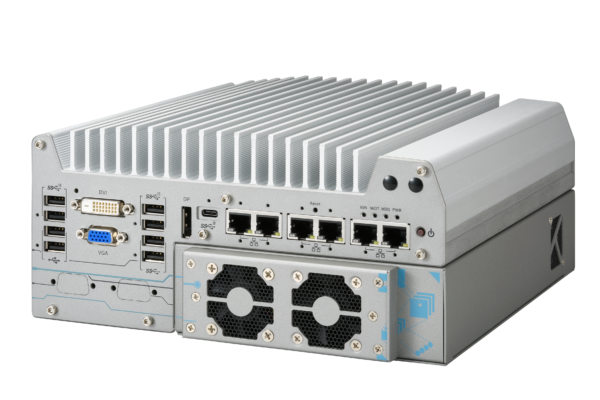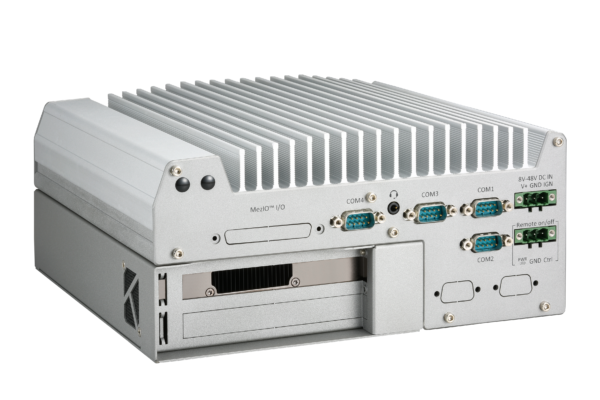In this article:
- Neousys Unleashes a New Generation of Edge AI Inference Computer Supporting Intel® 13th/ 12th–Gen Core CPU and NVIDIA® L4 GPU
- Experience Unmatched AI Performance with Neousys Technology's Nuvo-9166GC Series
- Discover the Advantages of the NVIDIA® L4 Tensor Core GPU
- Suitable Applications for Nuvo-9166GC
- Key Features - Nuvo-9166GC Series

Neousys Unleashes a New Generation of Edge AI Inference Computer Supporting Intel® 13th/ 12th–Gen Core CPU and NVIDIA® L4 GPU
Neousys Technology, a leading provider of rugged embedded systems, is proud to introduce its latest cutting-edge AI inference computer, the Nuvo-9166GC. This advanced platform, powered by Intel 13th/12th-Gen processors and NVIDIA L4 technology, delivers exceptional CPU computing power and AI inference capabilities.
With its flexible camera connectivity, the Nuvo-9166GC is perfectly suited for applications requiring real-time responses from multiple cameras, including industrial AI inspection, robotic guidance, and advanced autonomous machines. As smart manufacturing and smart cities continue to grow, Neousys is at the forefront of the edge computing revolution through its collaboration with Intel and NVIDIA.
Experience Unmatched AI Performance with Neousys Technology's Nuvo-9166GC Series
Neousys Technology introduces the Nuvo-9166GC, a powerhouse of AI computing designed to elevate your applications. Featuring Intel Core CPUs with up to 24 cores and 32 threads, this system delivers nearly double the CPU computing performance compared to 11th/10th Gen platforms, ensuring seamless handling of AI tasks.
The Nuvo-9166GC harnesses the immense power of the NVIDIA L4, a data centre-grade GPU built on NVIDIA’s Ada Lovelace architecture, enabling energy-efficient AI acceleration applications. With capabilities reaching up to 30.3 TFLOPS in FP32 or an impressive 485 TOPS in INT8, it sets new industry standards for industrial edge AI computing.
Reliable operation under extreme conditions is paramount for edge systems, and the Nuvo-9166GC excels in this regard. It boasts a proven design that guarantees performance in temperatures ranging from -25°C to 60°C. The system’s passive-cooling design for the CPU and DDR5 memory module ensures optimal thermal management. Moreover, its patented Cassette module, complete with an air tunnel, ensures a continuous flow of cool air through the passive heat sink of the NVIDIA L4, maintaining peak performance.
When it comes to camera connectivity, the Nuvo-9166GC offers versatility with six GbE ports, six USB3 ports, MezIO expansion options, and an additional PCIe slot. This configuration supports up to fourteen industrial GigE cameras or eighteen industrial USB3 cameras, allowing for comprehensive camera integration.
To handle the data generated by multiple cameras, the Nuvo-9166GC provides two 2.5″ SATA HDD/SSD slots supporting RAID 0/1 configurations. Additionally, it features an M.2 2280 Gen4x4 slot that supports an NVMe SSD, delivering exceptional read/write speeds of up to 7000 MB/s for swift and efficient operating system installations.
Embrace the future of edge computing with Neousys Technology’s Nuvo-9166GC. Its exceptional performance, robust thermal management, and extensive camera connectivity make it the ideal choice for your AI-driven applications. Experience the next level of AI computing now.
“Our mission is to empower industries with next-gen GPU edge computers. As one of the pioneers to release a ruggedized Intel 13th/12th-Gen Core industrial computer with support for a data center grade GPU, we continue to utilise the power of the NVIDIA GPUs to benefit intelligent manufacturing industries.” Kaichu Wu, Product Manager at Neousys Technology.
Discover the Advantages of the NVIDIA® L4 Tensor Core GPU
Why choose the NVIDIA L4 Tensor Core GPU? As the next-generation successor to the NVIDIA Tesla T4, the L4 Tensor Core GPU harnesses the cutting-edge Ada Lovelace architecture. It boasts an impressive capability of delivering 485 INT8 TOPS, making it a powerhouse for various applications.
This GPU is designed for outstanding performance, offering exceptional throughput, low latency, and high AI computation efficiency per watt. It excels in tasks related to video, AI, visuals, graphics, virtualisation, and more. Whether you’re operating at the edge, in a data centre, or in the cloud, the NVIDIA L4 Tensor Core GPU, with its cost-effective and efficient low-profile form factor, is the ideal solution for your needs.
Unlock the potential of your server infrastructure with the NVIDIA L4 Tensor Core GPU and experience a new level of performance and efficiency.
Suitable Applications for Nuvo-9166GC
Enhancing Robotic Guidance with AI Inference Computers
In the ever-evolving landscape of robotics, the integration of Artificial Intelligence (AI) inference computers has emerged as a revolutionary approach to significantly improve the precision and efficiency of robotic guidance systems. AI inference computers are designed to process complex data, make real-time decisions, and execute tasks with unparalleled accuracy. In this article, we will delve into how AI inference computers are transforming the field of robotic guidance and their practical applications.
AI in Robotic Guidance: A Paradigm Shift
Robotic guidance involves the ability of robots to navigate and interact with their environment effectively. Traditionally, this required intricate programming and predefined paths, limiting the adaptability of robots in dynamic settings. However, the integration of AI inference computers has introduced a paradigm shift by enabling robots to perceive, interpret, and respond to their surroundings in real time.
Sensory Perception and Object Recognition
One of the core aspects of robotic guidance is sensory perception, which involves the robot’s ability to understand its surroundings through sensors like cameras, LiDAR, and depth sensors. AI inference computers excel in processing sensory data by leveraging advanced algorithms and neural networks for object recognition. This allows robots to identify objects, obstacles, and landmarks in their environment with a high degree of accuracy.
Path Planning and Navigation
AI inference computers empower robots with the capability to plan optimal paths and navigate through complex environments seamlessly. They can factor in dynamic obstacles, adjust routes in real time, and make split-second decisions to avoid collisions or detours. This level of adaptability is especially valuable in applications like autonomous vehicles, warehouse automation, and industrial robots.
Human-Robot Collaboration
In collaborative robotic settings, where robots work alongside humans, AI inference computers play a crucial role in ensuring safety and efficiency. These computers can process data from sensors and cameras to detect the presence and movements of humans. This enables robots to adjust their actions in real time, ensuring a safer and more harmonious human-robot interaction.
Quality Control and Inspection
In industries such as manufacturing and quality control, precision is paramount. AI inference computers enhance the capabilities of robots by enabling them to perform intricate inspections and quality control tasks with a level of accuracy that is difficult to achieve through manual processes. They can identify defects, anomalies, or deviations in real time, ensuring that products meet stringent quality standards.
Dynamic Object Manipulation
For tasks that involve picking, placing, and manipulating objects, AI inference computers provide robots with the ability to adapt to various shapes, sizes, and orientations of objects. By processing visual data in real time, robots can make precise adjustments and execute tasks like sorting, packaging, or assembly with a high degree of efficiency and accuracy.
Real-Life Applications
The integration of AI inference computers in robotic guidance has found applications in various industries:
Logistics and Warehousing: AI-powered robots are increasingly used for autonomous material handling, including picking and transporting items in warehouses, optimizing inventory management, and improving order fulfilment.
Healthcare: Surgical robots equipped with AI inference computers assist surgeons with precision and dexterity, reducing the risk of human error and improving patient outcomes.
Agriculture: Autonomous agricultural robots use AI to navigate fields, detect and remove weeds, and optimize planting and harvesting operations.
Retail: AI-equipped robots are employed for inventory management, shelf restocking, and providing customer assistance in retail stores.
Construction: Construction robots utilize AI for tasks such as bricklaying, concrete pouring, and excavation, enhancing productivity and safety on job sites.

Revolutionising Quality Control: How AI Inference Computers are Transforming AI Inspection
AI inspection has become a cornerstone of quality control in various industries, from manufacturing to healthcare. This cutting-edge technology harnesses the power of Artificial Intelligence (AI) to detect defects, anomalies, and deviations with unmatched precision. In this article, we will explore how AI inference computers are revolutionizing AI inspection and their diverse applications across industries.
AI Inspection: A Game-Changer in Quality Control
AI inspection is a process that employs machine learning algorithms to analyse data from sensors, cameras, or other sources and make intelligent decisions based on predefined criteria. Traditional inspection methods often fall short in detecting subtle defects or variations, leading to higher error rates and increased production costs. AI inspection, on the other hand, is able to process vast amounts of data in real time, ensuring consistent and reliable quality control.
Enhanced Accuracy through AI Inference Computers
At the heart of AI inspection lies the role of AI inference computers. These specialized computing systems are designed to process AI models, making real-time decisions based on data analysis. Their advanced capabilities empower AI inspection systems to achieve levels of accuracy that are simply unattainable through manual inspection or conventional machine vision systems.
Versatile Applications of AI Inspection
AI inspection has found applications across various industries, and AI inference computers have played a pivotal role in enabling these applications:
Manufacturing Quality Control
In manufacturing, AI inspection ensures that products meet stringent quality standards. AI inference computers equipped with AI models can identify defects, deviations, or irregularities in real time, leading to reduced production costs and improved product quality. Industries such as automotive, electronics, and textiles rely heavily on AI inspection to maintain high-quality production lines.
Healthcare Imaging: In the healthcare sector, AI inspection is used for medical imaging analysis. AI inference computers process medical images like X-rays, MRIs, and CT scans to detect anomalies, tumors, fractures, and other medical conditions. This technology assists healthcare professionals in making more accurate diagnoses and treatment decisions.
Food and Beverage Quality Control: AI inspection systems equipped with AI inference computers play a pivotal role in the food and beverage industry. They can identify contaminants, ensure correct labelling, and verify the quality of food products, reducing the risk of recalls and ensuring food safety.
Electronics Manufacturing: In electronics manufacturing, AI inspection is crucial for identifying defects in printed circuit boards (PCBs), microchips, and other electronic components. AI inference computers enhance the speed and accuracy of defect detection, minimizing production errors and optimizing product quality.
Pharmaceutical Production: Pharmaceutical companies rely on AI inspection to maintain the quality and integrity of their products. AI inference computers help identify inconsistencies in drug manufacturing, ensuring that medications meet regulatory requirements and are safe for consumption.
Aerospace and Automotive Industries: In the aerospace and automotive sectors, AI inspection ensures the integrity of critical components. AI inference computers are used to inspect aircraft parts, engines, and automotive components for defects that could compromise safety and performance.
Future Innovations in AI Inspection
As AI technology continues to advance, so does the potential for innovation in AI inspection. AI inference computers are becoming increasingly powerful and energy-efficient, enabling faster and more comprehensive inspections. Integration with Internet of Things (IoT) devices and edge computing further enhances the real-time capabilities of AI inspection systems.
Empowering Intelligent Video Analytics with AI Inference Computers
In the age of rapidly advancing technology, Intelligent Video Analytics (IVA) has emerged as a transformative force across various industries. This cutting-edge technology leverages Artificial Intelligence (AI) to analyse video data and extract valuable insights, making it an invaluable tool for enhanced security, productivity, and decision-making.
Intelligent Video Analytics: A Game-Changer
IVA is a multifaceted field that involves the use of AI algorithms to process and interpret video data from cameras, sensors, and other sources. It enables systems to automatically detect, track, and analyse objects, people, or events in real time. This technology empowers businesses and organizations to make data-driven decisions, improve security, streamline operations, and enhance overall efficiency.
AI Inference Computers: The Engine Behind IVA
At the core of IVA systems are AI inference computers. These specialised computing devices are designed to run AI models efficiently, making real-time decisions based on the analysis of video data. AI inference computers serve as the brains of IVA solutions, enabling them to process massive amounts of video data, identify patterns, and provide actionable insights.
Applications of AI Inference Computers in IVA
AI inference computers have found diverse applications in the field of IVA, transforming various industries:
Video Surveillance and Security: AI inference computers are used to monitor security cameras in real time, identifying suspicious activities, intrusions, and unauthorized access. They enable facial recognition for access control and tracking individuals of interest, enhancing security in public places, airports, and facilities.
Retail Analytics: In retail, AI inference computers analyse customer behaviour and foot traffic, helping businesses optimise store layouts, product placements, and inventory management. They enable cashier-less checkout experiences, reducing queuing times and enhancing the overall shopping experience.
Smart Cities: AI inference computers are crucial for traffic management, monitoring traffic flow, and detecting accidents or congestion. They enhance public safety by analysing video data from surveillance cameras to detect incidents and respond promptly.
Manufacturing: In manufacturing, AI inference computers monitor production lines for quality control, identifying defects or anomalies in real time. They support predictive maintenance, helping prevent equipment breakdowns and downtime.
Healthcare: In healthcare settings, AI inference computers analyse video data from medical imaging devices, assisting in the early detection of diseases and abnormalities. They aid in patient monitoring and fall detection in hospitals and nursing homes.
Transportation: In transportation and logistics, AI inference computers optimise route planning, track vehicle conditions, and monitor driver behaviour for safety and efficiency. They play a vital role in autonomous vehicles, enabling object detection and collision avoidance.
Revolutionising Teleoperation with AI Inference Computers
Teleoperation, the remote control of machines and devices, has been significantly transformed by the integration of Artificial Intelligence (AI) inference computers. These advanced computing systems are at the forefront of enhancing teleoperation in various fields, from robotics and healthcare to exploration and beyond. In this article, we’ll explore how AI inference computers are shaping the future of teleoperation.
Teleoperation: A Remote Control Revolution
Teleoperation allows humans to remotely control machines and equipment from a distance. Historically, this has been vital in fields such as space exploration, hazardous environments, and manufacturing. However, teleoperation posed challenges related to latency, precision, and the need for highly skilled operators. AI inference computers are changing the game by introducing intelligence and autonomy into teleoperation systems.
AI Inference Computers: The Brainpower Behind Teleoperation
At the core of modern teleoperation systems are AI inference computers. These specialized computing devices are equipped with high-performance GPUs (Graphics Processing Units) and are designed to process AI models efficiently. AI inference computers enable machines to make real-time decisions based on data analysis, significantly improving the accuracy and responsiveness of teleoperation systems.
Applications of AI Inference Computers in Teleoperation
AI inference computers are finding diverse applications in the field of teleoperation, revolutionising industries in the following ways:
Robotic Teleoperation: In robotics, AI inference computers enable remote control of robots with increased precision and responsiveness. This is particularly valuable in scenarios where human operators need to manipulate robots in challenging environments, such as disaster recovery or hazardous waste handling.
AI-equipped robots can perform complex tasks like object recognition and navigation autonomously, reducing the workload of human operators.
Healthcare and Telemedicine: In healthcare, AI inference computers facilitate telemedicine by enhancing the control of surgical robots during remote procedures.
Surgeons can remotely operate robotic surgical instruments with greater precision, reducing the need for physical presence in the operating room.
Space Exploration: In space exploration, AI inference computers are instrumental in controlling rovers and spacecraft from Earth. They enable real-time decision-making, allowing scientists and engineers to remotely explore distant planets and conduct experiments.
Agriculture: In agriculture, teleoperation systems equipped with AI inference computers assist in remotely controlling agricultural machinery, such as autonomous tractors and drones. These systems enable precise and efficient farm operations, from planting and harvesting to crop monitoring.
Mining and Construction: In mining and construction, teleoperation systems powered by AI inference computers allow operators to remotely control heavy machinery in hazardous environments. This enhances safety and efficiency in industries where human presence may pose risks.
Telepresence and Education: In telepresence applications, AI inference computers improve the realism of remote communication by enhancing audio-visual quality and interactivity.
They enable immersive telepresence experiences for remote workers, students, and participants in virtual events.
Key Features - Nuvo-9166GC Series

Supports NVIDIA L4 GPU and one additional PCIe card
Supports Intel 13th/12th-Gen Core up to 16C/ 24T 35W/ 65W
Dedicated heat dissipation for -25°C to 60°C wide-temperature operation

5x 2.5GbE and 1x GbE with optional PoE+ (ports 3~6)
1x USB 3.2 Gen2x2 type-C and 6x USB 3.2 type-A ports
M.2 2280 M key socket (Gen4x4) supporting NVMe SSD
Accommodates two 2.5″ SATA HDD/ SSD with RAID 0/ 1 support










